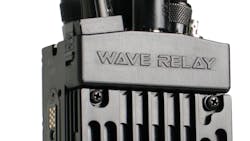The U.S. Army is looking to Persistent Systems, LLC for the development of manned-unmanned (MUM) radio communications systems for the future. Secure communications systems will be needed for connecting human soldiers with robotic and autonomous systems in the field, and the U.S. Army Combat Capabilities Development Command C5ISR Center is awarding a $5.4 million contract to Persistent Systems for MPU5 contested manned-unmanned operations that includes reliable and secure communications between human soldiers and robotic machines in the field.
The Army envisions a robust radio communications system for the next-generation optionally manned fighting vehicle (OMFV) that can be networked with as many as four unmanned remote combat vehicles (RCVs) and their assorted sensor/weapon payloads and in turn networked with larger command forces. Such capabilities will require a robust, secure and high-throughput communications network. “The Army wants RCVs that can be remotely operated in groups over very long distances in cities, forests and open terrain,” said Brian Soles, vice president of business development for Persistent Systems. “These manned-unmanned teams will also have to deal with the threat of enemy hacking and jamming.”
Persistent Systems and its Wave Relay radio is a leading supplier of mobile ad hoc networking (MANET) communications systems. Its MPU5 radios provide a variety of different communications links without the need for external communications infrastructure, such as 4G or 5G cellular wireless communications equipment. Its MPU5 radios have already been deployed in a variety of different unmanned platforms and feature an onboard Android computer to host and run command-and-control and situational awareness software and a 3 × 3 multiple-input, multiple-output (MIMO) antenna configuration capable of producing as much as 10 W transmit power. “The application of the work done under this contract won’t be limited to vehicles,” Soles said. “The idea is to get these same hardened capabilities to dismounted soldiers, which will greatly enhance our ability to operate against more sophisticated adversaries.”
About the Author
Jack Browne
Technical Contributor
Jack Browne, Technical Contributor, has worked in technical publishing for over 30 years. He managed the content and production of three technical journals while at the American Institute of Physics, including Medical Physics and the Journal of Vacuum Science & Technology. He has been a Publisher and Editor for Penton Media, started the firm’s Wireless Symposium & Exhibition trade show in 1993, and currently serves as Technical Contributor for that company's Microwaves & RF magazine. Browne, who holds a BS in Mathematics from City College of New York and BA degrees in English and Philosophy from Fordham University, is a member of the IEEE.
